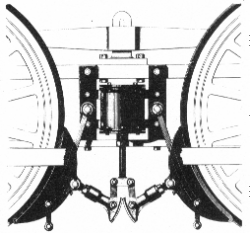 SKC Films Library SKC Films Library |
| |
| SKC Films Library >> Technology >> Railroad Engineering and Operation >> Railway Equipment and Supplies |
| Railroad Air Brakes The first air brakes were developed during the 1860's by George Westinghouse, a young engineer who got the idea after reading about a compressed-air drill. The same principle used by the drill produced railroad brakes so safe that the system is still in use. To set the brakes, an engineer pulls a lever which reduces the air presure in a hose connecting all the cars. This reduction releases the valve of a pressurized air reservoir under each car (above), allowing air to flow into a brake cylinder between the wheels (below).
Here the pressurized air forces down a piston, which sets a pair of brake shoes against the wheels. Any accident which breaks the air hose will thus stop the train automatically. PRINT SOURCE SEE ALSO |
SKC Films Library >> Technology >> Railroad Engineering and Operation >> Railway Equipment and Supplies This page was last updated on March 18, 2017. |
